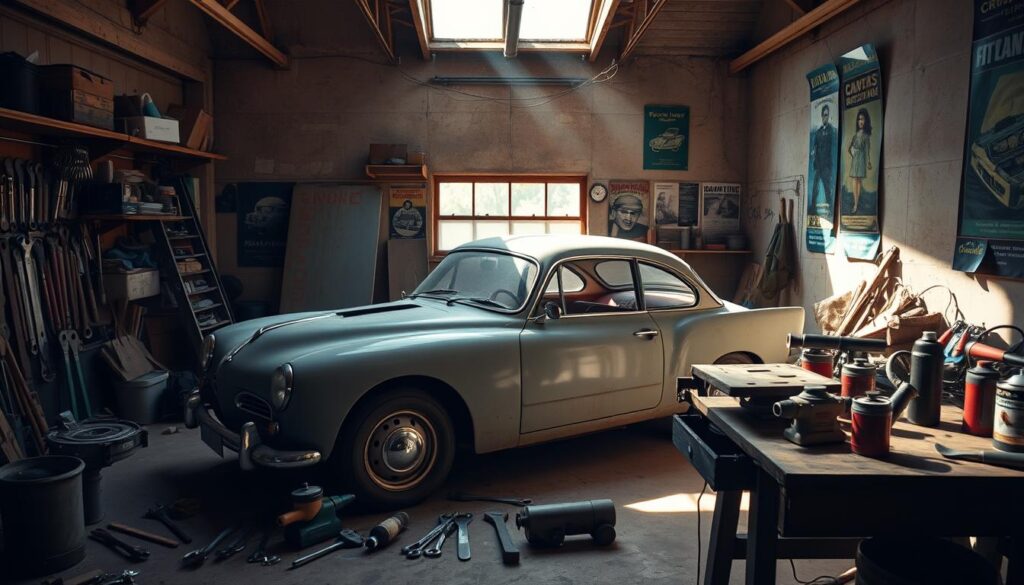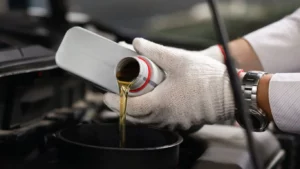If you love classic cars and dream of restoring one, you’re in the right spot. This guide will show you how to start your car restoration journey. It’s perfect for both seasoned enthusiasts and newcomers to automotive restoration.

Restoring a classic car is a labor of love. The joy of preserving automotive history makes it rewarding. We’ll cover everything from understanding the restoration process to choosing the right project vehicle. You’ll also learn about sourcing tools and workspace, and tackling the restoration journey’s various stages. So, get ready to explore how to start car restoration, classic car restoration, automotive restoration, and restoring vintage cars.
Key Takeaways
- Discover the joy and satisfaction of preserving automotive history through car restoration
- Learn the essential steps to start your car restoration project, from choosing the right vehicle to sourcing the necessary tools and workspace
- Understand the various stages of the car restoration process, including stripping, engine and drivetrain rebuilding, bodywork, and interior restoration
- Gain insights into the best practices and expert tips for a successful car restoration
- Explore the resources and community support available to help you along your car restoration journey
Passion for Preserving Automotive History
Restoring classic cars is more than a hobby. It’s a deep passion for keeping the automotive history alive. Whether you love the sleek look of vintage sports cars or the rugged charm of antique trucks, classic car restoration lets you connect with history. It brings these gems back to life.
Understanding the Joy of Car Restoration
The joy of restoring vintage cars comes from the journey itself. It’s about solving problems and seeing a neglected car become a masterpiece. With each project, you learn about the stories and craftsmanship of the past. It’s a labor of love, restoring each part with care.
Choosing the Right Project Vehicle
Choosing the right car for automotive restoration is crucial. Think about your skills, budget, and what you like. Whether it’s your first project or adding to your collection, the excitement of restoring a classic is unmatched.
- Evaluate your mechanical expertise and set realistic goals
- Determine a budget that fits your financial capabilities
- Identify a car that resonates with your personal interests and aesthetic
Embracing the passion for preserving automotive history is a rewarding journey. The classic car restoration process is not just about the end result. It’s about the journey itself, filled with discovery, challenge, and satisfaction.
“The love of automobiles is a passion that transcends time and generations. Restoring a classic car is a chance to connect with the past and create something truly remarkable.”
How to start car restoration?
Starting a car restoration project is rewarding for car lovers. It’s a challenge but also very fulfilling. We’ll guide you through the first steps to begin your car restoration journey.
Assess the Vehicle’s Condition
First, check the car thoroughly. Look at the body, engine, and inside for damage or wear. This tells you what needs fixing and helps plan your work.
Create a Restoration Plan
After checking the car, make a detailed plan. Include a timeline, budget, and steps for each part of the project. Planning helps keep your restoration organized and efficient.
Gather the Necessary Tools and Supplies
You’ll need a good workshop and the right tools. Get quality tools like a hydraulic jack and air compressor. Also, find the parts and materials you need for your project.
Start Disassembling the Vehicle
Now, start taking the car apart. Remove each part carefully and label them for easy reassembly. This helps you understand the car’s structure and find any hidden problems.
Remember, car restoration is a journey. It takes patience, detail, and a love for car history. Follow these steps to turn your project car into a masterpiece.
Essential Tools and Workspace Requirements
Starting a car restoration project needs the right tools and a tidy workspace. Having the essential car restoration tools and a dedicated area is key. It ensures your project goes smoothly and efficiently.
Must-Have Tools for Car Restoration
You’ll need a wide range of tools for your car restoration. Here’s a list of the automotive restoration equipment you should have:
- A comprehensive toolset: This includes wrenches, sockets, pliers, and screwdrivers for different tasks.
- Power tools: A grinder, sander, and impact wrench help speed up the work.
- Specialty tools: Dent pullers, body hammers, and trim removal tools are needed for detailed bodywork.
- Diagnostic equipment: A multimeter and code reader help with electrical and mechanical problems.
- Safety gear: Protective eyewear, gloves, and a respirator keep you safe while working.
Having these essential tools for car restoration prepares you for every step, from taking it apart to putting it back together.
Workspace Setup for Car Restoration
Setting up your workspace is just as important as having the right tools. Create a dedicated area with enough space, good lighting, and air. Think about these things when setting up your workspace:
- Spacious work area: Make sure you have enough room to move around the car and access all parts easily.
- Sturdy workbenches: Get a stable, well-lit workbench for taking things apart and doing detailed work.
- Storage solutions: Use shelves, cabinets, or tool chests to keep your tools, parts, and materials organized.
- Adequate lighting: Good overhead and task lighting help you see every detail of the car.
- Ventilation: Make sure your workspace has good airflow to keep out fumes and dust, either naturally or with a fan.
With a well-equipped and organized workspace for car restoration, you’ll work more efficiently and safely. This setup helps you stay productive and focused on your restoration journey.
Stripping the Vehicle: A Comprehensive Guide
Restoring a classic car is a labor of love. It starts with stripping the vehicle. This process is key to a successful restoration. By documenting and disassembling each part, you prepare your project vehicle for the rebuild.
Safety is crucial when stripping a vehicle for restoration. Wear gloves, goggles, and a respirator to protect yourself. Make sure your workspace is well-ventilated and organized. This helps you keep track of all parts and pieces.
- Start by removing the easy-to-access components, such as the interior trim, seats, and dashboard.
- Carefully disconnect the electrical system, taking note of each wire’s location and function.
- Disassemble the engine, transmission, and other drivetrain components, labeling and bagging each part to maintain organization.
- Strip the body panels, doors, and other exterior components, meticulously documenting their original placement and condition.
- Address any rust or damage, preparing the surface for the next phase of the car restoration process.
By following a thorough how to strip a car for restoration approach, you’ll ensure that every component is properly identified and preserved. This sets the stage for a successful rebuild. Remember, patience, attention to detail, and a commitment to preserving the integrity of your project vehicle are key.
“The key to successful car restoration is in the preparation. Stripping the vehicle is where the journey begins.”

Rebuilding the Engine and Drivetrain
The engine and drivetrain are at the heart of your car restoration. They are what make your vintage car come to life. Starting the engine rebuild for car restoration and transmission restoration is key to making your classic shine again.
Engine Rebuild Best Practices
Rebuilding the engine needs careful attention. Begin by checking each part, cleaning and replacing any that are worn or damaged. Disassemble the engine slowly, remembering the order and position of each piece.
With patience and precision, you can put the engine back together. Make sure every part is well-lubricated and in the right place.
Knowing the right engine rebuild methods is crucial. Spend time learning about your car’s specific needs for a successful rebuild.
Transmission and Drivetrain Restoration
The transmission and drivetrain repair for classic cars are also important. Check the transmission, differentials, and other parts for any problems. Fix any worn or malfunctioning parts.
Restoring your restoring vintage car engines and automotive drivetrain restoration needs careful detail and knowledge. With patience, skill, and the right tools, you can revive your classic car’s heart and soul.
Car restoration is a labor of love. Seeing your classic car run smoothly again is incredibly rewarding. Enjoy the journey, learn from others, and let your passion for automotive drivetrain restoration lead you to success.
Bodywork and Exterior Restoration
Restoring your classic car’s bodywork and exterior is key to its shine and elegance. You might need to fix rust, dents, or explore metal fabrication. This step is vital for the car’s look.
Rust Repair and Metal Fabrication
Rust is a big challenge in car restoration. It can weaken the car’s structure. So, it’s important to tackle it quickly. Experts use bodywork restoration and rust repair for classic cars to fix and replace damaged parts.
Metal fabrication is also crucial for car exterior restoration. Skilled metal workers create custom parts like panels and trim. This ensures your car’s body looks as good as new.
| Restoration Technique | Benefits |
|---|---|
| Rust repair for classic cars | Preserves the structural integrity of the vehicle |
| Metal fabrication for automotive restoration | Allows for custom, tailor-made components to achieve a perfect fit and finish |
By using bodywork restoration and metal fabrication, you can make your classic car look new again. It will regain its charm and appeal.

Interior Restoration: Bringing Back the Charm
The interior of a classic car is often overlooked but crucial. Bringing the cabin back to its former glory can greatly enhance your car’s look and feel. This includes everything from upholstery to worn-out parts, all part of classic car interior refurbishment.
Restoring the interior’s charm begins with a detailed check-up. Look at the seats, door panels, carpet, and more to see what needs fixing. Upholstery repair for automotive restoration is a precise task that requires a keen eye for detail.
After figuring out what needs fixing, you can start the restoration. Whether it’s reupholstering seats or replacing old parts, aim to restore vintage car interiors to their best. Using authentic materials and fabrics is key to getting the look right.
Remember, interior restoration for classic cars is more than just making it look good. It’s about keeping the car’s history and character alive. By carefully restoring the interior, you’re not only making the car more appealing but also honoring its original craftsmanship.
“The interior is the heart of the car, where the driver and passengers interact with the machine. Bringing it back to life is a true labor of love.”
Starting your journey in restoring vintage car interiors can be rewarding. With the right approach and focus on detail, you can give the interior a new lease on life. This will make your classic car experience even more special.
Electrical System and Wiring Basics
Starting your classic car restoration? Learning about the automotive electrical system and wiring is key. Whether you’re fixing automotive electrical system restoration, classic car wiring repair, or restoring vintage car electrical components, knowing the basics helps. It lets you face any electrical problems in classic cars with confidence.
Diagnosing and Repairing Electrical Issues
First, you need to diagnose any electrical problems. Get to know the car’s wiring diagram and learn to use a multimeter. This helps find the problem’s source. Then, you can fix it, making sure every wire and part is perfect.
- Look for any damage, corrosion, or wear on the wiring. Replace anything that’s not good.
- Check if alternators, batteries, and other power sources work well. This keeps your electrical system reliable.
- Fix or replace any broken electrical modules, switches, or control units.
- Make sure lights, gauges, and accessories work right.
| Common Electrical Issues in Classic Cars | Troubleshooting Tips |
|---|---|
| Flickering or dim lights | Check for loose connections, faulty wiring, or a weak battery |
| Non-functioning accessories | Inspect fuses, relays, and wiring harnesses for issues |
| Intermittent electrical failures | Use a multimeter to test for voltage drops and short circuits |
With patience, detail, and the right tools, you can make your classic car’s electrical system shine again. Learning these electrical system and wiring basics will help you achieve a fully working, reliable, and restored vintage car.
Conclusion
As you finish your car restoration, think about how far you’ve come. You’ve worked hard to keep automotive history alive. Your dedication and love for classic cars shine through in your work.
You now know your car inside out. From the engine to the interior, you’ve learned a lot. This knowledge will make you appreciate car restoration even more. It also prepares you for future projects.
Completing your project is a big achievement. You’ve given a classic car a new lease on life. Your work helps keep our car culture alive. This experience will motivate you to keep restoring cars and maybe inspire others to do the same.
FAQ
What are the essential steps to start a car restoration project?
To start a car restoration, first, check the car’s condition. Then, make a plan for the restoration. You’ll need tools and a workspace.
Next, disassemble the car carefully. Start rebuilding the engine, drivetrain, bodywork, and interior. Take it one step at a time and make sure you have the right knowledge and tools.
How do I choose the right project vehicle for my car restoration?
When picking a project vehicle, think about your skill level, budget, and what you like. Choose a car that fits your interests and skills. Also, check the car’s condition to see if it’s good for restoration.
What tools and equipment do I need for a car restoration?
You’ll need basic hand tools, power tools, and special tools for car work. You’ll also need tools for metalwork, painting, and upholstery. Make sure you have a good workspace with enough space, light, and air.
How do I properly strip and disassemble a car for restoration?
Disassembling the car carefully is key. Follow a step-by-step plan and document each part’s location and condition. Use safety gear and the right tools. Keep all parts organized and labeled.
What are the best practices for rebuilding the engine and drivetrain?
Rebuilding the engine and drivetrain means inspecting, cleaning, and putting everything back together. Follow the manufacturer’s instructions and use the right parts. Pay close attention to how you assemble everything to make sure it works well.
How do I tackle the bodywork and exterior restoration?
Fixing the bodywork and exterior means dealing with rust, dents, and paint damage. You might need to fix metal, use body filler, and repaint the car. Pay attention to detail and preparation to get the car looking great.
What steps are involved in interior restoration?
Interior restoration makes the cabin look new again. This includes fixing or replacing upholstery, updating the dashboard, and making sure the interior looks good with the exterior. It’s important for a classic car to look and feel authentic.
How do I ensure the electrical system and wiring are in proper working order?
Fixing electrical issues is crucial in car restoration. Check the wiring, find and fix problems, and make sure the electrical system works right. This keeps your car running smoothly and safely.






